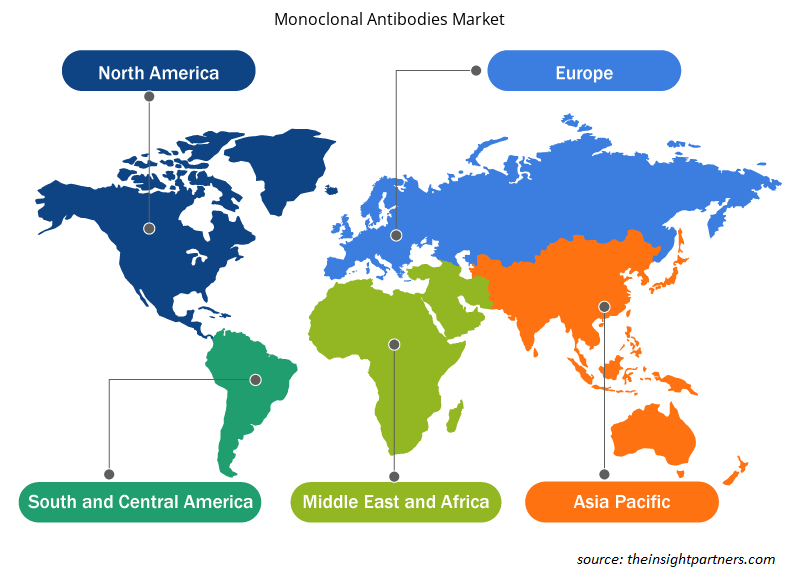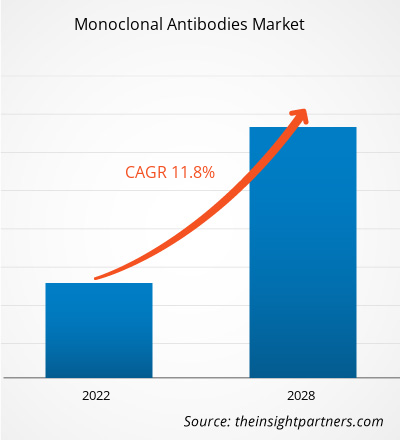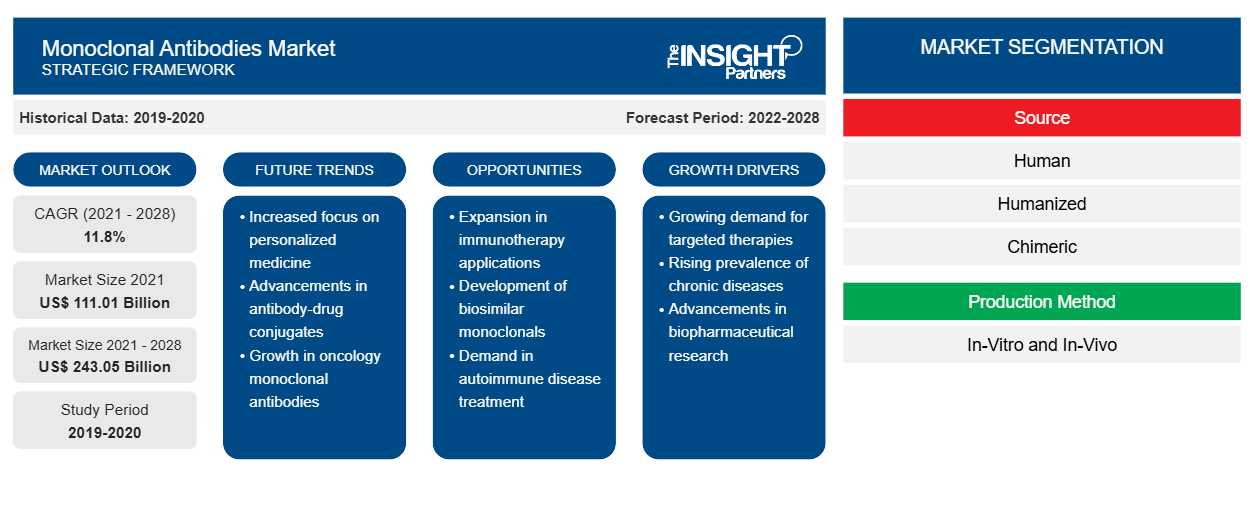モノクローナル抗体市場は、2021年の1,110.1億米ドルから2028年には2,430.5億米ドルに達すると予測されており、2021年から2028年にかけて11.8%のCAGRで成長すると予想されています。
がんやその他の慢性疾患の罹患率の増加と、さまざまな地域でのCOVID-19症例の大幅な増加は、市場の成長を促進する主な要因です。世界がん研究基金と米国がん研究所によると、2020年には約1,810万件のがん症例が記録され、そのうち男性は930万件、女性は880万件でした。さまざまな種類のがんの治療におけるモノクローナル抗体の使用は、まだフェーズ2およびフェーズ3の試験段階にあります。
北米は、 2021年から2028年にかけてモノクローナル抗体市場で優位を維持する可能性が高い。米国はこの地域で最大の市場シェアを占めており、予測期間中も引き続き市場の主要株主になると予想されています。Globocan 2020が発表した統計によると、米国では約1,806,590件の新たな癌症例が診断され、約606,520人がこの病気で亡くなりました。米国商務省の報告書によると、同省の国立標準技術研究所(NIST)は、国立バイオ医薬品製造技術研究所に1億5,300万米ドルの資金提供を発表しました。さらに、FDAはCOVID-19の流行中にモノクローナル抗体の開発に対する支援を拡大しています。
要件に合わせてレポートをカスタマイズする
このレポートの一部、国レベルの分析、Excelデータパックなど、あらゆるレポートを無料でカスタマイズできます。また、スタートアップや大学向けのお得なオファーや割引もご利用いただけます。
- このレポートの主要な市場動向を入手してください。この無料サンプルには、市場動向から見積もりや予測に至るまでのデータ分析が含まれます。
市場分析
がんやその他の慢性疾患の罹患率の大幅な上昇が市場の成長を牽引
アメリカがん協会の報告によると、2019年1月時点で、がんの病歴を持つ人が約1,690万人米国に居住しています。人口の増加と高齢化により、2030年1月までにがん生存者の人口は2,210万人に増加すると推定されています。したがって、がんやその他の慢性疾患の罹患率が上昇するにつれて、モノクローナル抗体(mAB)などの生物学的製剤の需要も急増しています。生物学的製剤は、多くの治療計画や費用対効果の高い治療の主成分として、がん治療において重要な役割を果たしています。
ソースベースの洞察
情報源に基づいて、モノクローナル抗体市場は、マウス、キメラ、ヒト、ヒト化に分類されます。 ヒトセグメントは、2021年から2028年の間に最大の市場シェアを占めると推定されています。 このセグメントの市場成長は、さまざまな種類の感染症の治療のためのヒトモノクローナル抗体の統合による増加に起因しています。 たとえば、リジェネロンは、COVID-19で使用するために、FDA承認の抗体カクテルカシリビマブとイムデビマブを一緒に発売しました。 この薬は、FDAから緊急使用許可(EUA)を受けています。 成人だけでなく、少なくとも12歳以上で体重が40kg以上の小児患者の軽度から中等度のCOVID-19の治療に使用されます。 さらに、さまざまな慢性疾患での使用の増加と高度な遺伝子工学技術の採用は、市場セグメントの成長を促進する重要な要因の1つです。
兆候に基づく洞察
適応症に基づいて、がん、自己免疫疾患、炎症性疾患、感染症、微生物性疾患など。今後数年間はがんセグメントが市場を支配するでしょう。モノクローナル抗体の治療への応用に関する進歩により、乳がん、肺がん、大腸がんなど、さまざまな種類のがんの治療にモノクローナル抗体をうまく導入できるようになりました。これらの抗体に基づく薬は、がん細胞のフラグ付け、細胞膜の破壊の誘発、免疫系阻害剤のブロックなどに役立ちます。 FDAは2020年6月、前立腺がんの治療薬としてオラパリブとルカパリブの2つの薬を承認しました。この薬は、前立腺がんが広がったり転移したりして標準的なホルモン治療に反応しなくなった男性、つまり去勢抵抗性疾患に特に効果的です。
エンドユーザーベースの洞察
エンドユーザー別に見ると、モノクローナル抗体市場は病院、研究機関、その他に分類されます。特にがん治療において、優先治療ラインとしてモノクローナル抗体の採用が増加しているため、病院セグメントが最大の市場シェアを占めています。
モノクローナル抗体市場で事業を展開する企業は、世界中で変化する顧客の需要を満たすために製品イノベーション戦略を採用しており、これにより世界市場で自社のブランド名を維持することも可能になっています。
モノクローナル抗体市場の地域別分析
予測期間を通じてモノクローナル抗体市場に影響を与える地域的な傾向と要因は、Insight Partners のアナリストによって徹底的に説明されています。このセクションでは、北米、ヨーロッパ、アジア太平洋、中東およびアフリカ、南米および中米にわたるモノクローナル抗体市場のセグメントと地理についても説明します。

- モノクローナル抗体市場の地域別データを入手
モノクローナル抗体市場レポートの範囲
| レポート属性 | 詳細 |
|---|---|
| 2021年の市場規模 | 1,110.1億米ドル |
| 2028年までの市場規模 | 2,430.5億米ドル |
| 世界のCAGR(2021年~2028年) | 11.8% |
| 履歴データ | 2019-2020 |
| 予測期間 | 2022-2028 |
| 対象セグメント | 出典別
|
| 対象地域と国 | 北米
|
| 市場リーダーと主要企業プロフィール |
|
モノクローナル抗体市場のプレーヤー密度:ビジネスダイナミクスへの影響を理解する
モノクローナル抗体市場は、消費者の嗜好の変化、技術の進歩、製品の利点に対する認識の高まりなどの要因により、エンドユーザーの需要が高まり、急速に成長しています。需要が高まるにつれて、企業は提供を拡大し、消費者のニーズを満たすために革新し、新たなトレンドを活用し、市場の成長をさらに促進しています。
市場プレーヤー密度とは、特定の市場または業界内で活動している企業または会社の分布を指します。これは、特定の市場スペースに、その市場規模または総市場価値に対してどれだけの競合相手 (市場プレーヤー) が存在するかを示します。
モノクローナル抗体市場で事業を展開している主要企業は次のとおりです。
- ノバルティスAG
- ファイザー株式会社
- グラクソ・スミスクライン
- アムジェン社
- 第一三共株式会社
免責事項:上記の企業は、特定の順序でランク付けされていません。

- モノクローナル抗体市場のトップキープレーヤーの概要を入手
モノクローナル抗体市場 - セグメンテーション
モノクローナル抗体市場は、その供給源に基づいて、ヒト、ヒト化、キメラ、マウスに分類されます。製造方法別には、市場はインビトロとインビボに分類されます。モノクローナル抗体市場は、適応症別に、がん、自己免疫疾患、感染症、炎症性疾患、微生物性疾患、その他にさらに分類されます。用途別には、市場は治療用途、診断用途、研究用途に細分化されます。さらに、エンドユーザーに基づいて、市場は病院、その他、研究機関に分類されます。
モノクローナル抗体市場 - 地域別
- 北米
- 私たち
- カナダ
- メキシコ
- ヨーロッパ
- フランス
- ドイツ
- イタリア
- 英国
- スペイン
- その他のヨーロッパ
- アジア太平洋(APAC)
- 中国
- インド
- 韓国
- 日本
- オーストラリア
- その他のアジア太平洋地域
- 中東およびアフリカ(MEA)
- 南アフリカ
- サウジアラビア
- アラブ首長国連邦
- MEAの残り
- 南米と中米(詐欺)
- ブラジル
- アルゼンチン
- 残りの詐欺
企業プロフィール
- ノバルティスAG
- ファイザー株式会社
- グラクソ・スミスクライン
- アムジェン社
- 第一三共株式会社
- F. ホフマン・ラ・ロシュ AG
- アストラゼネカ
- エリー・リリー・アンド・カンパニー
- バイエルAG
- ブリストル・マイヤーズスクイブ社
- 過去2年間の分析、基準年、CAGRによる予測(7年間)
- PEST分析とSWOT分析
- 市場規模価値/数量 - 世界、地域、国
- 業界と競争環境
- Excel データセット
最新レポート
お客様の声
購入理由
- 情報に基づいた意思決定
- 市場動向の理解
- 競合分析
- 顧客インサイト
- 市場予測
- リスク軽減
- 戦略計画
- 投資の正当性
- 新興市場の特定
- マーケティング戦略の強化
- 業務効率の向上
- 規制動向への対応





















 無料サンプルを入手 - モノクローナル抗体市場
無料サンプルを入手 - モノクローナル抗体市場